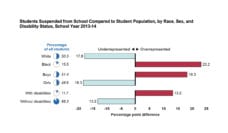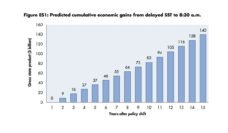Massachusetts’ 8th graders are currently ranked number one on the National Assessment of Educational Progress for mathematics. With an average score of 297, the state’s middle schoolers are significantly above the national average of 283. But this marker of educational attainment hides stark gaps between students of color and their White peers. Black and Latino students scored an average of 271 and 274 respectively on the test. As depicted in the figure, the test scores of Black and Latino students in Massachusetts are similar to the score of students in the lowest performing states.
Other academic assessments show a similar disparity between Massachusetts students. Black and Latino students scored two grade levels below their White counterparts on the 2015 Program for International Student Assessment. The Massachusetts Comprehensive Assessment System scores reveal that less than a third of Black, Latino, or low-income students read on grade-level by the end of third grade.
While test scores for all students have increased over the past two decades, the disparity between racial and socioeconomic groups still persists. This may be partially due to changes in funding policies over the same time period. Massachusetts has historically allocated approximately 15% more state and local funds to high-poverty school districts than to the low- poverty school districts. But in recent years, wealthier districts have received roughly the same amount of state and local funding per student as low-poverty districts.
Revising education funding is one way the state can begin to close current gaps in academic achievement. Such initiatives have the potential to address inequities beyond differential test scores because academic achievement—which is associated with low school drop-out–affects occupation, income, and is a major predictor of health outcomes.
Databyte via #1 For Some: Opportunity & Achievement in Massachusetts. Number 1 for Some.














